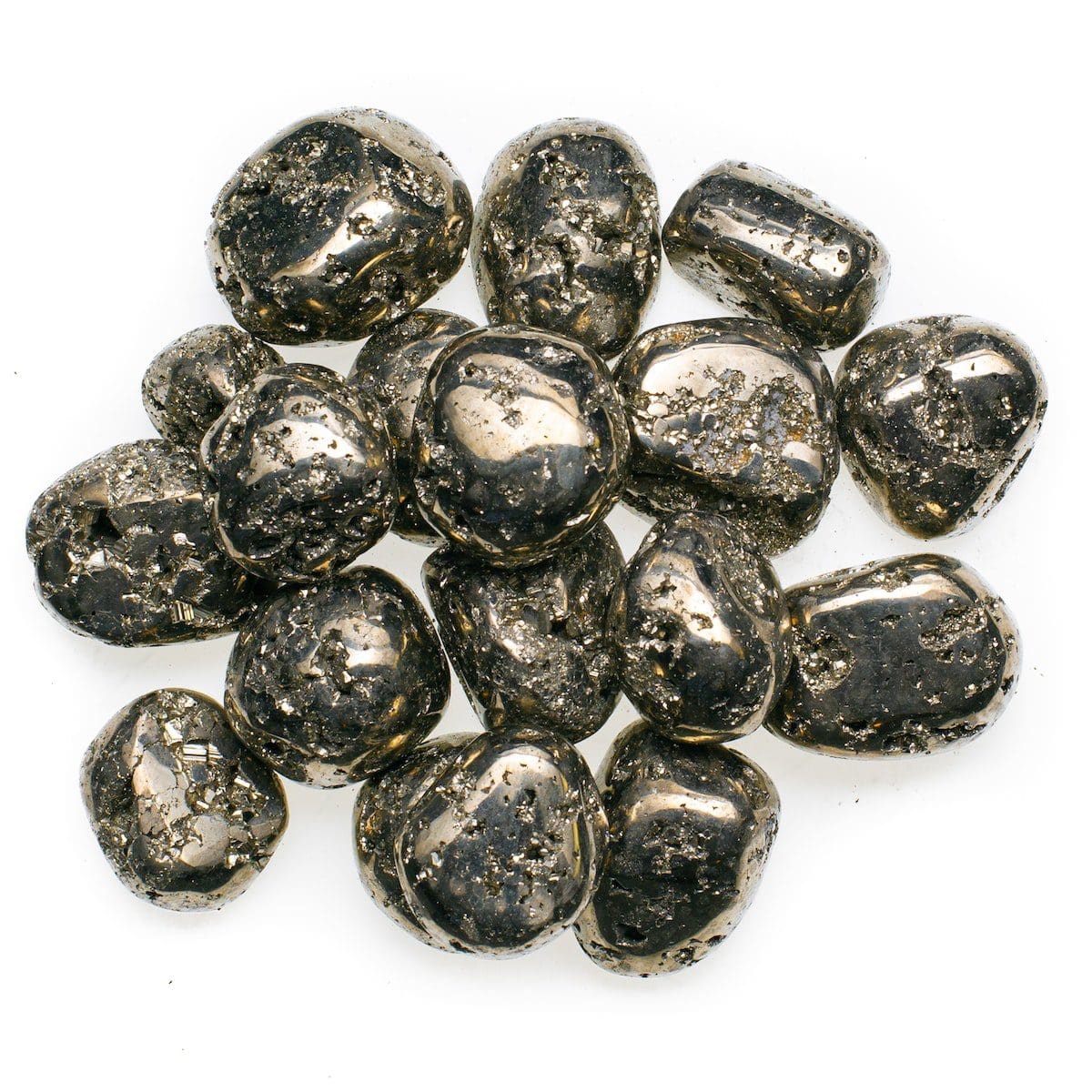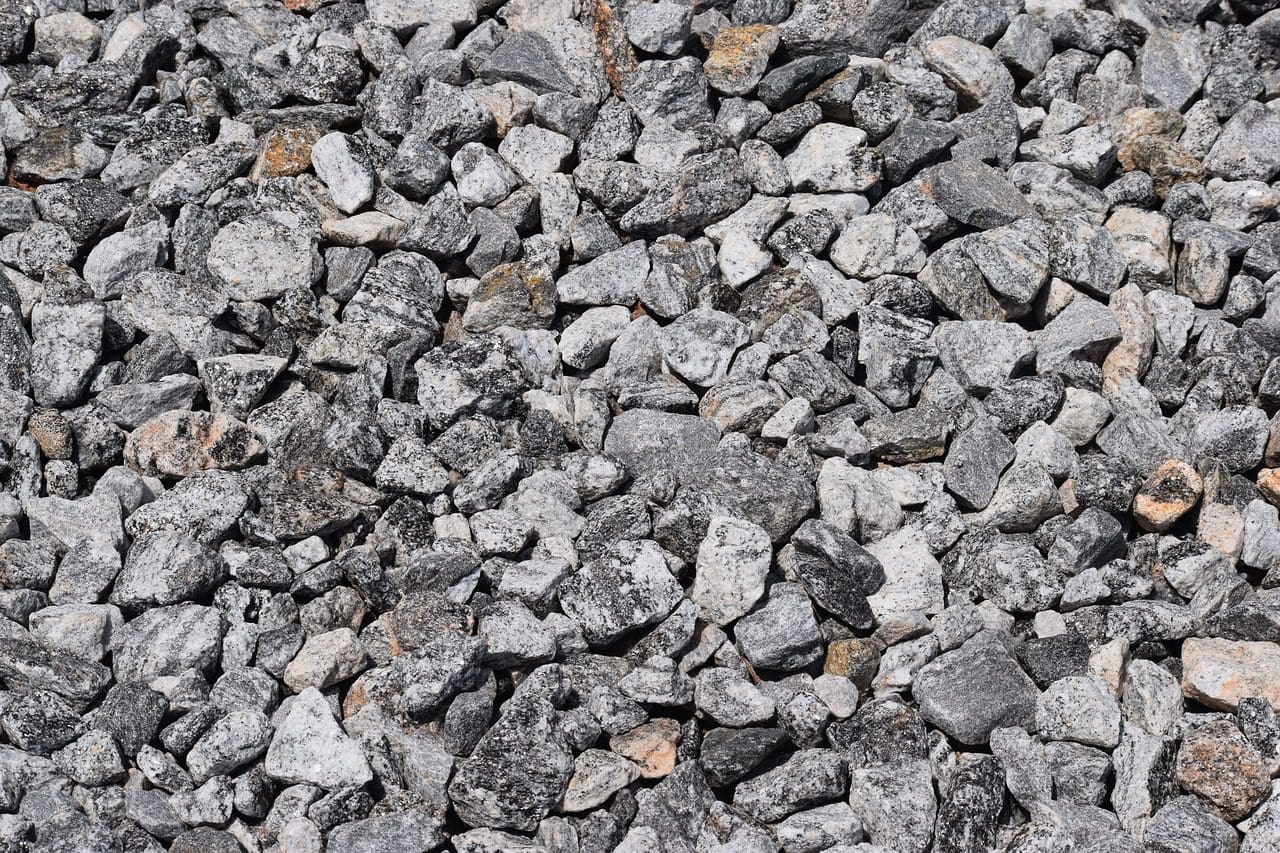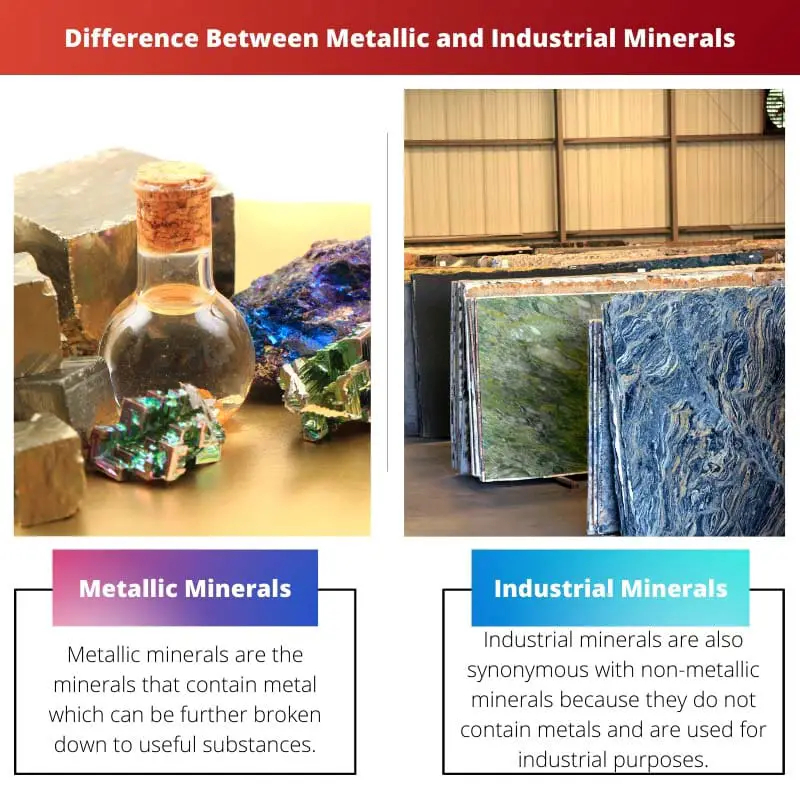Metallic minerals are primarily composed of metals like iron, copper, and gold, essential for industrial applications such as construction, electronics, and manufacturing. On the other hand, industrial minerals include non-metallic resources like limestone, gypsum, and quartz, crucial for diverse sectors like construction, agriculture, and ceramics.
Key Takeaways
- Metallic minerals contain metals in their raw form, such as iron, copper, and gold, which can be extracted and refined for various uses.
- Industrial minerals are non-metallic minerals used in various industries for construction, manufacturing, and agriculture, including limestone, gypsum, and talc.
- The primary distinction between the two is their composition and usage: metallic minerals contain metals. They are used in metal production, while industrial minerals are non-metallic and have various industrial applications.
Metallic vs Industrial Minerals
The difference between metallic and industrial minerals is that in metallic minerals metals occur in the raw form, which can be further extracted for functional purposes. In contrast, industrial or non-metallic minerals are substances that lack the presence of metals in them.

Metallic minerals are minerals that contain one or more than one metals. These occur in rare and naturally occurring concentrations as mineral deposits.
Industrial minerals, called non-metallic substances, do not contain metals and are used in various industries to produce multiple products.
Metallic minerals are the excellent conductor of heat and electricity due to the presence of metals, whereas Industrial minerals are the poor conductor of heat and electricity.
Metallic minerals can be further classified into two more categories that are:
- Ferrous minerals- the metallic minerals which contain iron are called ferrous metallic minerals. Ex. Iron ore, manganese, nickel, etc.
- Non-ferrous minerals- the metallic minerals not containing iron are called non-ferrous minerals—Ex—aluminium, lead, copper, etc.
Comparison Table
| Feature | Metallic Minerals | Industrial Minerals |
|---|---|---|
| Composition | Contain one or more metals | Do not contain metals (primarily) |
| Key Properties | Shiny luster, good conductors of heat and electricity, malleable & ductile | Variable properties depending on the mineral, generally not shiny or good conductors |
| Main Use | Extracting metals for various applications | Used for their non-metallic properties in construction, manufacturing, and other industries |
| Examples | Iron ore, copper, gold, bauxite (aluminum) | Limestone, sand, clay, gypsum, diamond |
| Formation | Often found in igneous and metamorphic rocks | Often found in sedimentary rocks |
| Processing | Requires extraction and refining to obtain metals | Generally used in their natural state or minimally processed |
What are Metallic Minerals?
Characteristics of Metallic Minerals
- Luster: Metallic minerals exhibit a characteristic metallic luster, which imparts a shiny and reflective appearance to their surfaces.
- Conductivity: One of the distinguishing features is their high electrical conductivity, allowing them to conduct electricity and heat efficiently.
- Malleability and Ductility: Metallic minerals are typically malleable and ductile, meaning they can be easily shaped into thin sheets (malleability) and drawn into wires (ductility).
- Opaque Nature: Unlike non-metallic minerals, metallic minerals are generally opaque to light.
Types of Metallic Minerals
Ferrous Minerals
Ferrous minerals contain iron as their main constituent and are vital for various industries, especially the iron and steel sector. Examples include hematite, magnetite, and siderite.
Non-Ferrous Minerals
Non-ferrous metallic minerals do not contain iron as the principal element. Common non-ferrous metallic minerals include copper, lead, zinc, gold, and silver.
Precious Metals
Precious metals, such as gold, silver, and platinum, are highly valued for their rarity and unique properties. They find applications in jewelry, currency, and electronics.
Occurrence and Extraction
Geological Formation
Metallic minerals are formed through various geological processes, including magmatic segregation, hydrothermal processes, and sedimentary processes.
Mining Techniques
The extraction of metallic minerals involves mining techniques such as open-pit mining, underground mining, and placer mining, depending on the depth and location of the deposits.
Economic Significance
Contribution to GDP
The mining and processing of metallic minerals significantly contribute to the economic development of nations by generating revenue and providing employment opportunities.
Industrial Applications
Metallic minerals serve as essential raw materials for a wide range of industries, including construction, manufacturing, electronics, and transportation.
Environmental Impact
Ecological Footprint
Mining activities associated with metallic minerals can have environmental consequences, including habitat disruption, soil erosion, and water pollution.
Sustainable Practices
Efforts are being made to implement sustainable mining practices, such as reclamation and responsible extraction techniques, to minimize the environmental impact of metallic mineral extraction.

What are Industrial Minerals?
Types of Industrial Minerals
1. Silicate Minerals
Silicate minerals are the most abundant group of industrial minerals and include minerals like quartz, feldspar, and mica. They are widely used in the production of glass, ceramics, and abrasives.
2. Carbonate Minerals
Carbonate minerals, such as limestone and dolomite, find applications in the construction industry for the production of cement and as raw materials in various chemical processes.
3. Sulfate Minerals
Sulfate minerals like gypsum are essential in construction for producing plaster and wallboard. Gypsum is also used in agriculture as a soil conditioner.
4. Phosphate Minerals
Phosphate minerals, including apatite, are vital in the production of fertilizers, supporting global agriculture by providing essential nutrients to plants.
5. Clay Minerals
Clay minerals like kaolin and bentonite are utilized in the ceramics industry, as well as in the production of drilling muds, cosmetics, and pharmaceuticals.
6. Graphite
Graphite is a unique industrial mineral with applications in the production of lubricants, batteries, and as a crucial component in the emerging field of graphene technology.
Extraction and Processing
Industrial minerals are typically extracted through mining or quarrying. The extraction process varies depending on the specific mineral and its intended use. Once extracted, minerals undergo processing, which may include crushing, grinding, and purification to meet the required specifications for various industries.
Applications
1. Construction Industry
Industrial minerals like sand, gravel, and limestone are essential in the construction of buildings, roads, and infrastructure.
2. Glass and Ceramics Industry
Silicate minerals, particularly quartz and feldspar, are integral in the production of glass and ceramics.
3. Chemical Industry
Various industrial minerals serve as raw materials in chemical processes, contributing to the production of fertilizers, acids, and other chemicals.
4. Agriculture
Phosphate minerals play a crucial role in agriculture by serving as a primary component in fertilizers, promoting plant growth.
5. Technology and Electronics
Industrial minerals like graphite and rare earth elements are indispensable in the manufacturing of electronic devices, batteries, and other technological applications.
Market Trends
The industrial minerals market is influenced by factors such as technological advancements, economic growth, and environmental regulations. In recent years, there has been a growing emphasis on sustainable sourcing and environmentally friendly processing methods within the industry.
Challenges and Future Outlook
While industrial minerals are indispensable in various industries, challenges such as fluctuating market demands, geopolitical factors affecting the supply chain, and environmental concerns associated with extraction and processing processes pose ongoing challenges. The future outlook for industrial minerals involves a balance between meeting global demand and adopting sustainable practices to minimize environmental impact.

Main Differences Between Metallic and Industrial Minerals
- Composition:
- Metallic Minerals: Contain metals in their chemical composition. Examples include iron ore (hematite), copper ore (chalcopyrite), and gold (native gold).
- Industrial Minerals: Primarily composed of non-metallic elements or compounds. Examples include limestone, gypsum, and silica.
- End Use:
- Metallic Minerals: Often used for metal extraction and production, contributing to the manufacturing of tools, machinery, and alloys.
- Industrial Minerals: Utilized in various industries for their physical and chemical properties, such as construction, agriculture, and manufacturing.
- Physical Properties:
- Metallic Minerals: Typically have metallic luster, high density, and good conductivity of heat and electricity.
- Industrial Minerals: Exhibit diverse physical properties, including hardness, cleavage, and specific gravity, depending on their intended industrial application.
- Economic Value:
- Metallic Minerals: Valued for their metal content, which can lead to high market demand and prices.
- Industrial Minerals: Prized for their specific non-metallic properties, often contributing to the manufacturing and construction sectors.
- Extraction Process:
- Metallic Minerals: Extracted through mining and various metallurgical processes, such as smelting and refining.
- Industrial Minerals: Extraction methods vary and may involve processes like quarrying, crushing, and milling.
- Examples:
- Metallic Minerals: Iron ore, copper, gold, silver, and aluminum.
- Industrial Minerals: Limestone, gypsum, silica, talc, and potash.
- Global Distribution:
- Metallic Minerals: Found in a wide range of geological settings, including igneous, sedimentary, and metamorphic rocks.
- Industrial Minerals: Also found in diverse geological formations but may be more concentrated in specific environments suitable for their formation.
- Market Dynamics:
- Metallic Minerals: Prices influenced by factors such as global demand, geopolitical events, and technological advancements.
- Industrial Minerals: Prices influenced by industrial demand, construction activities, and changes in manufacturing processes.
- Environmental Impact:
- Metallic Minerals: Mining and processing can have significant environmental impacts, including habitat disruption and water pollution.
- Industrial Minerals: Extraction and processing may have varying environmental effects depending on the specific mineral and extraction methods used.

- https://bib.irb.hr/prikazi-rad?rad=305527
- https://www.inderscienceonline.com/doi/abs/10.1504/IJMME.2014.058921

The article effectively compares metallic and industrial minerals, elucidating their differences in a comprehensive manner. A valuable resource for those interested in mineralogy.
Absolutely. The detailed comparison offers a wealth of knowledge about metallic and industrial minerals, catering to the interests of mineral enthusiasts.
I agree. The article’s in-depth comparison between metallic and industrial minerals provides a solid understanding of their distinctions and applications.
This article provides a detailed and comprehensive explanation of both metallic and industrial minerals, their characteristics, and their applications. It is a valuable resource for anyone interested in geology and mining.
I completely agree. The comparison table provided in the article is particularly helpful in understanding the differences between metallic and industrial minerals.
Absolutely. The examples of metallic and industrial minerals and their applications further enhance the understanding of these concepts.
While the article provides a good overview of metallic and industrial minerals, the comparison could be further enhanced by including information about the extraction, refining, and processing methods for these minerals.
I see your point. A discussion on the extraction and processing methods would certainly add depth to the comparison between metallic and industrial minerals.
The article effectively delineates the differences between metallic and industrial minerals, offering valuable insights into their properties and applications. Informative and well-structured.
Indeed, the article provides a clear and structured overview of metallic and industrial minerals, making it an invaluable resource for those delving into geology and mining.
Absolutely. The structured and insightful content of the article serves as an excellent foundation for understanding the nuances of metallic and industrial minerals.
The detailed descriptions of metallic and industrial minerals in the article, along with their examples and applications, provide a depth of understanding on the topic.
I couldn’t agree more. The article’s in-depth explanations and examples enrich the understanding of metallic and industrial minerals.
Absolutely. The detailed descriptions and examples enhance the article’s value as a comprehensive resource for understanding metallic and industrial minerals.
The content presented in the article is informative and well-organized, making it easy to understand the differences between metallic and industrial minerals. Great work!
Absolutely. The clarity and organization of the content make it a valuable resource for those seeking knowledge about metallic and industrial minerals.
I couldn’t agree more. The article effectively elucidates the distinctions between metallic and industrial minerals in a clear and concise manner.
The article effectively highlights the elemental differences between metallic and industrial minerals, shedding light on their distinct characteristics and their applications. It serves as a great introduction to the topic.
I couldn’t agree more. This article serves as an excellent primer for anyone looking to understand the fundamentals of metallic and industrial minerals.
Although the article covers the basics of metallic and industrial minerals, it lacks in-depth information about specific types of metallic and industrial minerals. It would be beneficial to include more examples and detailed descriptions.
I agree with Morgan. More specific examples and detailed descriptions would make this article even more informative.
I understand your point. It would definitely add value to the article if specific examples of metallic and industrial minerals were provided.
The article is certainly informative and comprehensive in its comparison of metallic and industrial minerals, offering valuable insights into the world of mineralogy.
The article portrays a thorough comparison between metallic and industrial minerals, providing a wealth of information to readers interested in geology and mining. Well done!
I share your sentiment. The comprehensive nature of the comparison makes it an excellent reference for individuals seeking knowledge about metallic and industrial minerals.